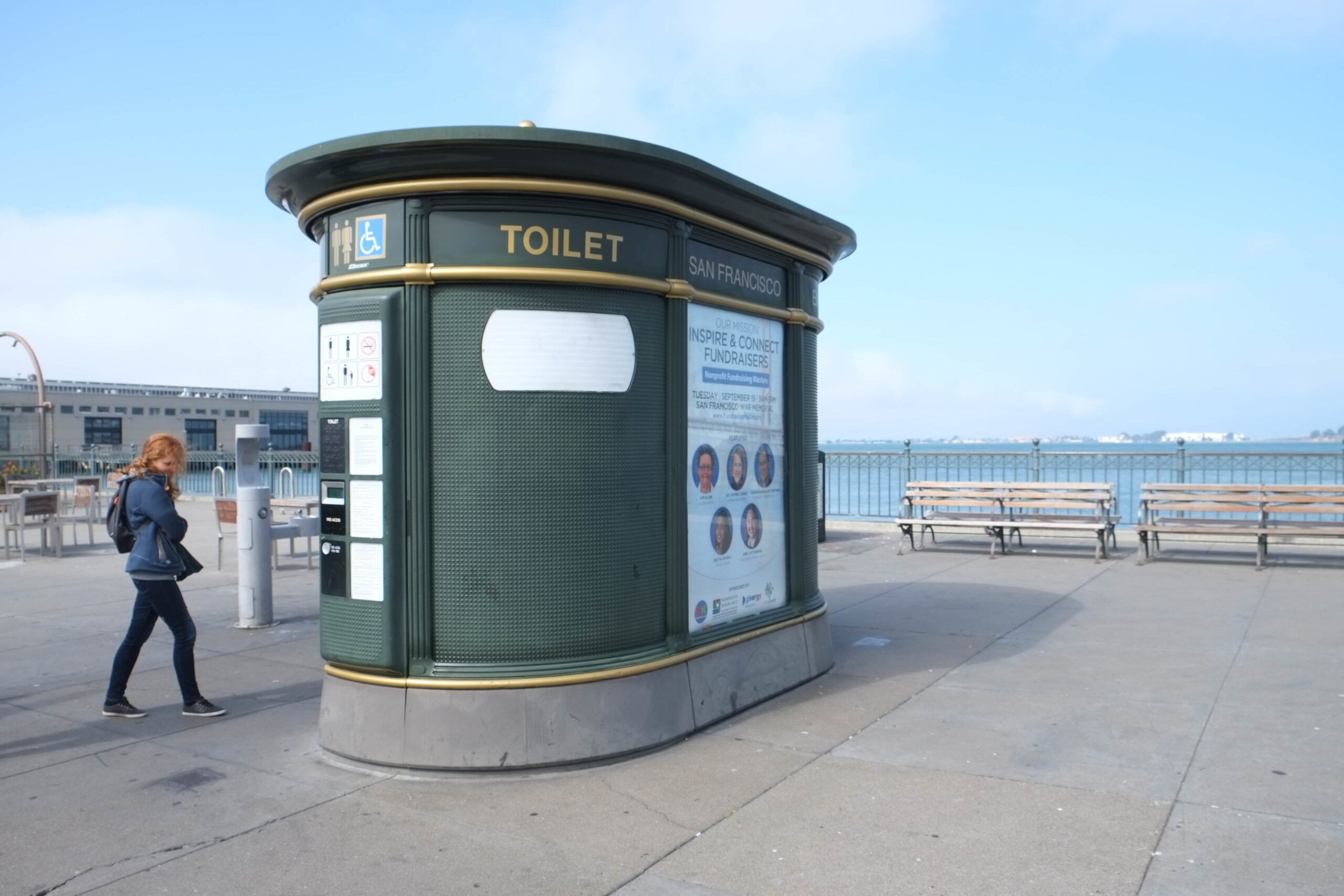Privatizing the loo: A solution for cities’ restroom debacle?
By D. Dowd Muska | November 21, 2025
Spend enough time researching the subject, and one can be forgiven for abandoning all hope. Simply put, America’s public restrooms are a disaster.
First, there aren’t enough of them. Writer Quinn O’Callaghan considers the lack of options when nature calls among the plagues of “the modern urban hell-scape that make living in cities from Philadelphia to New York to Chicago to Los Angeles less convenient every year.” In 2023, The New York Times groused that “the United States has only eight public toilets per 100,000 people, according to the Public Toilet Index, a 2021 report by the British company QS Bathrooms Supplies” — well below “Iceland, the country with the highest density of public bathrooms: 56 per 100,000 people.” The Scripps News Group noted that America’s score “is comparable with the rate in Botswana.”
Second, one needn’t look far for examples of cities’ inability to build what were once known as “comfort stations” cheaply and speedily. In 2024, the San Francisco Chronicle’s Alec Regimbal attended the opening of the “newly installed and much-anticipated public restroom” in “San Francisco’s cozy Noe Valley neighborhood.” With an original price tag of a whopping $1.7 million, the loo became a poster child for California’s unaffordable, red-tape-driven construction costs. Per KGO-TV, the city “found a way to build it for a lot less, thanks to the generosity of two companies that have decided to donate a modular restroom with labor included and a few extra features.” Nonetheless, Regimbal’s experience with the facility was “mediocre, if not crappy.”

To the south, Los Angeles is planning, in Agence France-Presse’s description, “a bathroom with two stalls at the entrance to the city’s popular Runyon Canyon hiking trail at a cost of $960,000.” One local harrumphed that the project is “an epic waste of money.” Small cities can fail to rise to the challenge, too. It took New Mexico’s capital eight years to build a 20-stall restroom for the heavily visited Santa Fe Plaza. The city’s facilities division director told KUNM that the project “ran into pandemic delays and increased costs,” and that “the new construction even required a call to archeologists when excavators found remnants of a very old power station buried underground.”
Finally, there’s the ick factor. The Wall Street Journal recently lamented: “New public bathrooms quickly become the kind of … facilities we’ve all had the unfortunate experience of entering in a moment of dire necessity, and then slowly backing away from.” The misdeeds come in many forms. Vandalism is common. n September, the Santa Monica Daily Press reported that the “homeless man responsible for tens of thousands of dollars in damage to beach bathrooms” who “escaped prosecution for the crime earlier this year” had “again forced the closure of [a] restroom facility.”
The Bradley Company’s annual Healthy Handwashing Survey consistently finds that a large majority of respondents have “had a particularly unpleasant experience due to the condition” of public bathrooms. Its latest poll found that “clogged or unflushed toilets, an old, dirty or unkempt appearance and unpleasant smells” were the top complaints. And, er, inappropriate amorousness is an additional pitfall. According to New York Public Radio, since June, hundreds of men have been arrested at Penn Station “as part of an aggressive crackdown by the federally run Amtrak Police Department on anonymous sex at the transit hub’s notorious bathrooms. “
OK, it’s bad. But enough whining. Here’s cause for optimism: The private sector thinks it can help.
The Portland Loo was created in 2006 by Rose City bureaucrats and a West Coast architectural firm, “in response to concerns about hygiene, safety and accessibility in public restrooms.” It is built by a for-profit entity. Boasting of “minimalist design and stainless steel material [that] keep it up and running for decades,” the Portland Loo “actively deters graffiti, loitering, drug use and other low-level crime that increase maintenance costs,” while consuming “significantly less water, electricity and materials than the standard restroom.” From Boise to Boston, Salt Lake City to Staten Island, and Modesto to Miami, customers appear to be satisfied. One Columbus official is particularly impressed:
The whole design of the restroom discourages crime. It’s a simple design, and everything is attached with security fasteners so it can’t be taken apart. … You could take a baseball bat to this and do basically no harm. One other safety measure I want to point out is the lighting on the interior is blue light, and that makes it difficult for people to see their veins. This is not a good venue for IV drug use.
Peculiar praise, but a D.C.-based startup thinks it can do better. Throne Labs envisions “a world in which people live their best lives — without worrying about where the closest restroom is.” Founded in 2020, the company’s units are “weather-proof and portable” and “intentionally designed to prevent and withstand all types of wear and tear.” Their “modular design allows us to respond quickly to damage and vandalism with on-site repairs.” Thrones are ADA compliant, and accessible “via mobile app, text or tap card.” Each user is limited to 10 minutes, and “24/7 monitoring” keeps “things moving” and “prevent[s] misuse.”
Michigan Enjoyer’s Bobby Mars extolled the company’s triumph in Ann Arbor: “Compared with your usual public facilities, this was the space shuttle of toilets. High-tech, with sliding doors, LED signs and a little red light where you wave your hand at the end to be let out.” Throne is “without a doubt, a victory of American capitalism.” Long Beach is pleased as well. The city recently extended its relationship with Throne, after a successful four-month pilot experiment.
Is urban America’s public-restroom nightmare coming to an end? Maybe. Government has certainly proven incapable of crafting a solution. There’s little to lose by empowering the private sector to find a fix.
